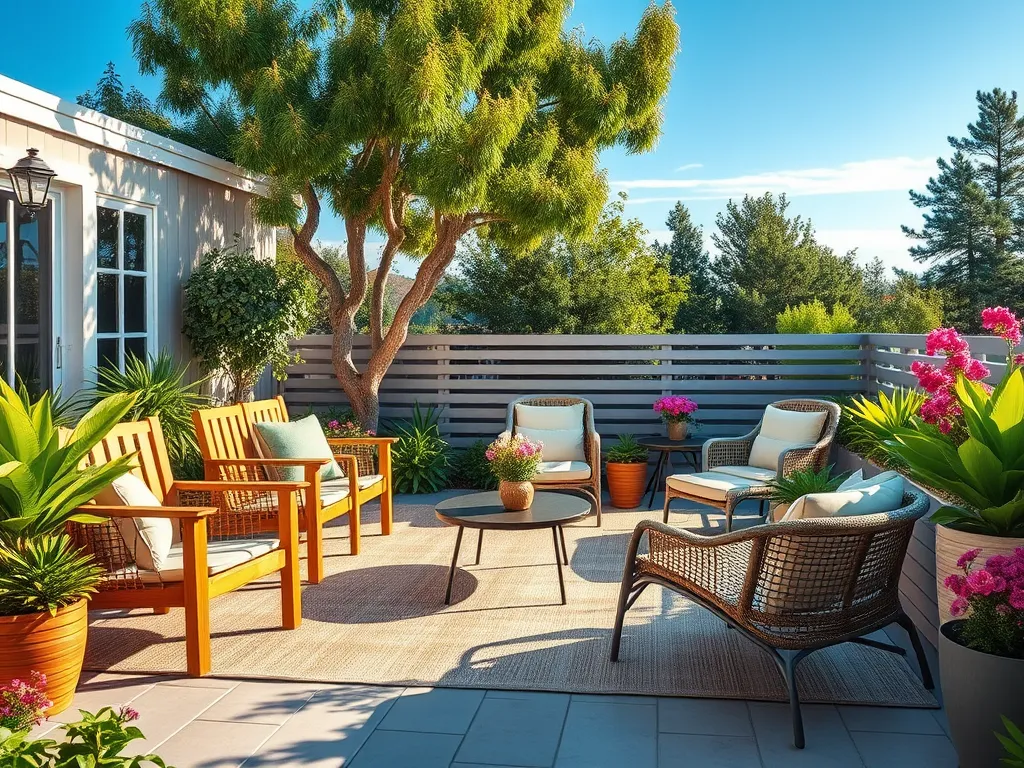Discover the Best Materials for Outdoor Furniture in 2023

Best Materials for Outdoor Furniture
When it comes to selecting outdoor furniture, the materials used are pivotal in determining its longevity, aesthetics, and comfort. The Best Materials for Outdoor Furniture ensure that your investment withstands the elements while providing a stylish and comfortable outdoor living space. This article delves into the most popular materials, highlighting their benefits and considerations.
Among the Best Materials for Outdoor Furniture, wood, metal, plastic, and fabric each offer distinct advantages. Wood provides a timeless appearance and warmth, while metals like aluminum and steel promise durability and modern designs. Plastic furniture has advanced significantly in quality, offering affordable and low-maintenance options. Fabric, particularly for cushions and upholstery, enhances comfort during outdoor lounging.
The choice of the Best Materials for Outdoor Furniture should also consider regional weather conditions. For instance, coastal areas may require materials that resist corrosion, while regions experiencing heavy rainfall will benefit from water-resistant options. Understanding the climate's impact on materials is crucial for making an informed decision that guarantees longevity for your outdoor furniture.
Furthermore, the aesthetic appeal of outdoor furniture materials plays a vital role in enhancing your outdoor area’s charm. Materials with various design options, color palettes, and textures can align with your personal style and landscape. The right selection creates a cohesive look that enriches your overall home decor.
Ultimately, selecting the Best Materials for Outdoor Furniture involves balancing aesthetics, durability, comfort, and cost-effectiveness. By understanding the characteristics of each material, you can identify the best fit for your lifestyle, ensuring a beautiful and functional outdoor space for years to come.
Durability of Outdoor Furniture Materials
Weather resistance is one of the most critical factors in determining the durability of outdoor furniture materials. Materials like teak and eucalyptus are highly resistant to moisture and decay, making them ideal for various climates. Metal finishes, such as powder coating, enhance corrosion resistance, allowing aluminum and steel options to excel even in harsh environments.
When designing your patio, consider the Best Materials for Outdoor Furniture to ensure durability and style.
Furthermore, longevity in various climates plays a significant role in materials' durability. For instance, while wood can endure dry conditions well, it may face challenges in humid or wet climates unless treated properly. Similarly, some plastics can fade or become brittle in extreme temperatures, highlighting the importance of selecting materials suited for your specific environment to ensure lasting performance.
Maintenance requirements are also a crucial consideration. Some materials like metal and high-density polyethylene (HDPE) are low maintenance, requiring only occasional cleaning, while wood may need regular sealing, staining, or painting to maintain its appearance and integrity. Understanding your willingness to undertake maintenance tasks can greatly influence your choice of materials.
Aesthetic Appeal of Outdoor Furniture Materials
When considering the aesthetic appeal of outdoor furniture materials, color options are abundant. Wood can be left natural or stained in various shades, while metals can be powder-coated in countless colors. Plastic materials offer vibrant hues that remain intact over time, allowing for an expressive outdoor space.
Design trends further enhance the aesthetic choices available, ranging from minimalist modern designs to rustic, traditional looks. Current trends may favor sleek lines and open designs, encouraging airflow and visibility, while others may embrace bold, statement pieces that serve as focal points in outdoor decor.
Texture choices also play a significant role in the overall aesthetic appeal of outdoor furniture. Smooth finishes can produce a contemporary feel, while textured surfaces add depth and interest, appealing to the tactile senses. Fabrics used for cushions, such as canvas or solution-dyed acrylic, offer not only comfort but also visual texture that enhances the overall design.
Eco-Friendly Options for Outdoor Furniture
Sustainable materials have gained popularity among environmentally conscious consumers. Options like reclaimed wood, bamboo, and responsibly sourced hardwoods exemplify eco-friendly choices that also offer durability. Choosing sustainably sourced materials can contribute positively to the planet while maintaining a beautiful outdoor space.
Moreover, recycled content is increasingly being used in outdoor furniture manufacturing. Furniture made from recycled plastics or metals reduces waste and minimizes the demand for new materials, making eco-friendly furniture a great choice for promoting sustainability in your outdoor areas.
The impact on the environment is a significant consideration when selecting outdoor furniture materials. Sustainable options not only reduce ecological footprints but also encourage a circular economy, where materials are reused and repurposed, fostering a healthier planet for future generations.
Comfort Factors in Outdoor Furniture Materials
Cushioning technologies greatly enhance the comfort of outdoor furniture. High-density foam, gel-infused cushions, and water-resistant materials can ensure a pleasant seating experience, allowing for longer periods of enjoyment outside. Quality cushioning can also help maintain shape and performance over time.
Heat retention is a critical comfort factor, particularly in warm climates. Some materials, such as metal, can become hot to the touch under direct sunlight, while wood and particular plastics remain cooler. Selecting materials that are comfortable in your climate is vital for a satisfying outdoor experience.
Ergonomic design is another essential comfort factor in outdoor furniture. Pieces designed with body contouring and support in mind can significantly enhance comfort levels, encouraging prolonged relaxation and enjoyment in outdoor spaces. Investing in well-designed furniture ensures a comfortable experience for users of all ages.
Cost-Effectiveness of Outdoor Furniture Materials
Comparative pricing is an essential aspect when evaluating outdoor furniture materials. The initial investment can vary significantly. While natural hardwoods often command higher prices, metal and plastic can offer more budget-friendly options without sacrificing quality.
Long-term investment considerations should also be taken into account. Higher-end materials may have a steeper initial price but can save costs over time through durability and lower maintenance needs. Understanding the lifecycle costs is crucial for smart investments.
Finally, value for money is a decisive factor when selecting outdoor furniture materials. Considerations of durability, maintenance, aesthetic appeal, and comfort should align to ensure that your choice not only meets your immediate needs but also provides satisfaction and enjoyment for years to come.
